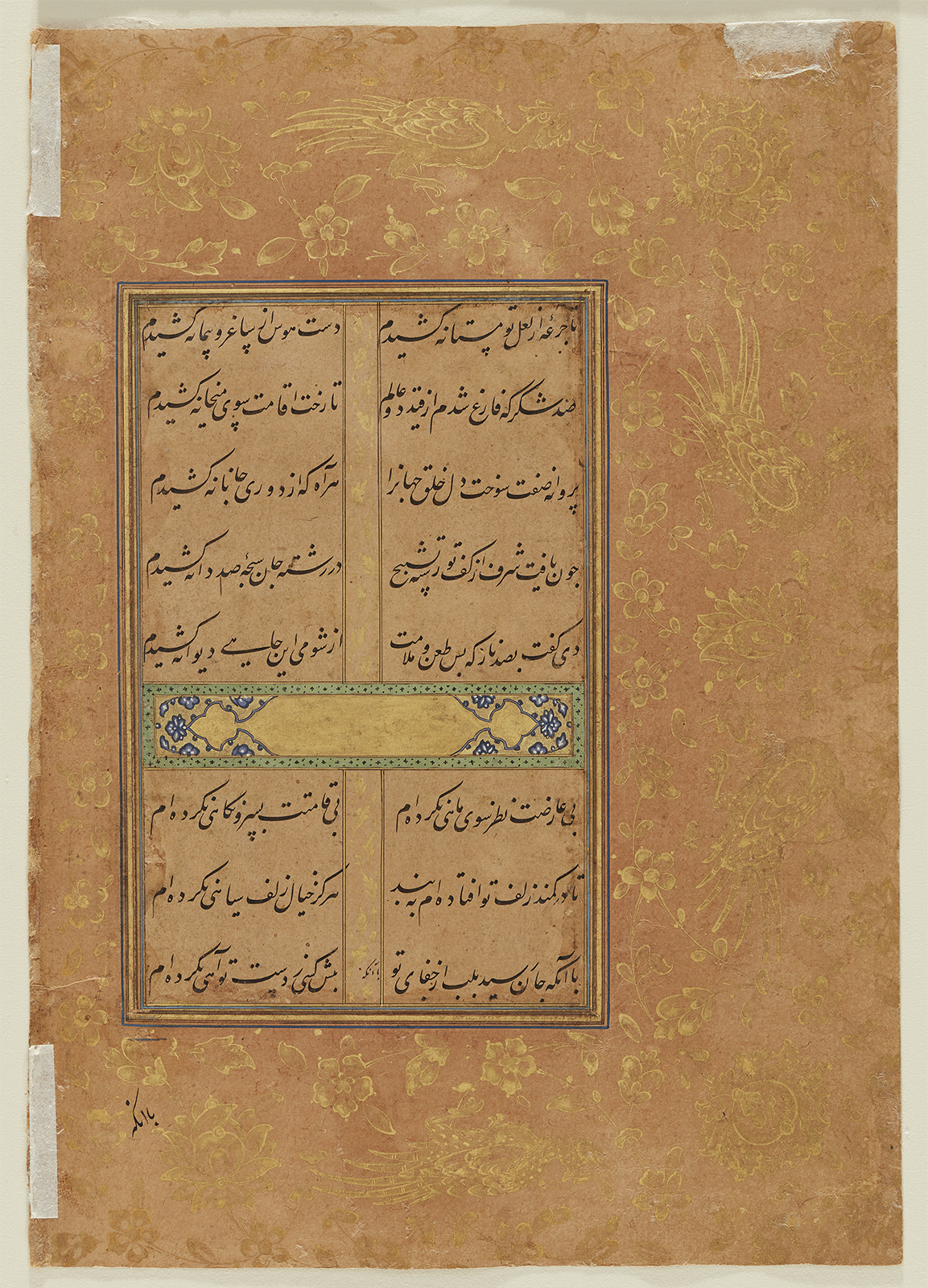Click on the image to zoom
Majnun in the wilderness
Folio from a manuscript of the Collected Works (Divan) of Sultan Ibrahim Mirza (fol. 36)
- Accession Number:AKM282.36
- Creator:Artist (calligrapher): `Abdullah al-Muzahhib
Artist (painter): `Abdullah al-Muzahhib
Compiled by: Gawhar Shad
Poet: Sultan Ibrahim Mirza, Persian, 1540 - 1577 - Place:Iran, Qazvin
- Dimensions:23.9 cm x 16.8 cm
- Date:1582-83 CE/990 AH
- Materials and Technique:opaque watercolour, ink, gold and silver on paper
The story of the star-crossed lovers Layla and Majnun is recounted in many works of classical Persian poetry, including the Khamsa (Quintet) by Nizami (1141–1209) and Amir Khusrau Dihlavi (1253–1325) and the Haft awrang (Seven Thrones) by Abdul-Rahman Jami (1414–92). Prevented by family and social pressures from marrying Layla, Majnun loses his reason (his name means “mad”) and goes off to live in the desert, where he becomes increasingly intimate with nature and its creatures. Like other examples of this scene, Majnun is depicted here in a mountainous landscape, rather than in a barren desert. He wears simple clothing and his hair and beard are unkempt and dishevelled. (Elsewhere he is often half-naked.) The animals surrounding him include a lion, its head partly effaced; several hares; a pair of gazelles; and a pair of horned ibex or mountain goats. That Majnun derives comfort from these companions is clear by the way he rubs the closest ibex’s nose. Meanwhile, a snow leopard seems ready to pounce from the rocky crag above, while a bear looks up in alarm. The couplet in the upper text panel gives poetic expression to Majnun’s lovelorn state:
With a group of wild beasts taking refuge like Majnun from this oppressive world,
My time of getting acclimated to the meadow of sorrows is drawing closer.
Further Reading
Sultan Ibrahim Mirza’s magnificent copy of the Haft awrang dating 1556–65 contains the complete account of Majnun’s unrequited love for Layla and his descent into madness, as narrated by the 15th-century poet Jami. It is not surprising, therefore, that the prince would incorporate imagery featuring Majnun in his own poetry or Divan. In general, however, the Divan follows a literary development known as the realist style or school that began in 16th century Iran. Poets writing in this mode used everyday language to characterize human emotions, particularly the simultaneous elation and disappointment of a lover’s ardent desire for a passive or even dismissive beloved (see AKM282.1). Yet realist poets did not altogether abandon the theme of mystical love, related to Sufi beliefs and practices. Sufism lies at the core of Jami’s poetry, and Sultan Ibrahim Mirza’s poem concerning Majnun can also be interpreted in mystical and metaphorical terms.[1] For example, the opening and closing couplets compare the beloved to a burning candle and the delirious lover (referred to at the end by the prince’s pen name of Jahi) to a butterfly being consumed by a flame:
Like a candle my enkindling is drawing closer
My being singed like a butterfly is drawing closer.
. . .
Dazzled by your love, O candle, like Jahi
My being consumed like a butterfly is drawing closer.
— Marianna Shreve Simpson, in collaboration with Chad Kia
Notes
1. For this interpretation, see also Ladan Akbarnia, Benoit Junod and Alnoor Merchant, eds., The Path of Princes: Masterpieces from the Aga Khan Collection (Lisbon: Calouste Gulbenkian Collection, 2008), cat. no. 35.
Note: This online resource is reviewed and updated on an ongoing basis. We are committed to improving this information and will revise and update knowledge about this object as it becomes available.




